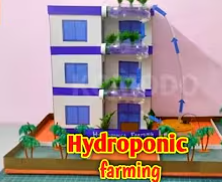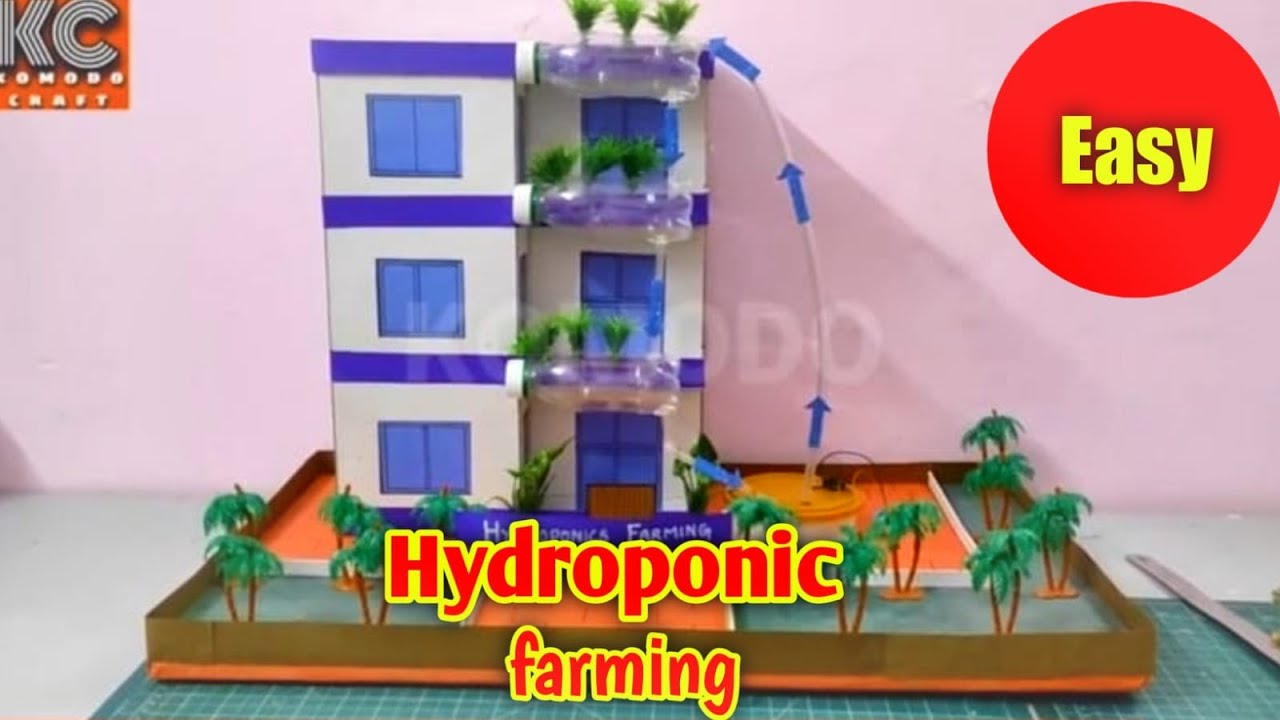
How to make Hydroponic farming working model
A hydroponic farming 3D working model serves as an excellent way to demonstrate the principles of hydroponics, providing a visual way to understand this innovative farming technique. Hydroponic farming is a modern method, soil-free method of growing plants that has gained popularity for its efficiency and sustainability. This technique uses nutrient-rich water to grow plants, making it easy solution for producing crops in areas with limited land.
Materials Needed for a Hydroponic Farming 3D Working Model
To create a hydroponic farming 3D model, gather the following materials:
- Transparent Plastic Container or Tubes
- Artificial Plant
- Water Pump / 6 V Pump : You can buy it from Amazon.
- Cardboard
- Colourful Pastel Sheet
- 9V battery
- ON / OFF Switch
- Wire
- Markers and Glue
- Waste Plastic small bottle
Step-by-Step: Building a Hydroponic Farming 3D Working Model
Step 1: Select One Method
There are many types of hydroponic systems to choose from, like:
• Nutrient Film Technique : In this system, a stream of nutrient solution flows steadily over the roots in a particular path.
• Deep Water Culture : Plants are suspended above a reservoir, allowing roots to grow into the oxygenated nutrient solution.
• Flood and Drain: Plants are periodically flooded with the nutrient solution, which then drains back into the reservoir.
Each type has unique advantages, so choose one based on the complexity and learning objectives of your model.
Step 2: Prepare the Base Structure
Select a transparent container to represent the main reservoir. If you are signify the DWC system, ensure it is large enough to hold both the nutrient solution and the air pump setup. If you’re using the NFT method, arrange PVC pipes at a slight angle to allow the nutrient solution to flow and recirculate all over.
Step 3: Set Up the Plant Holders
Insert net pots into openings in the PVC pipes or lid of the container, depending on your chosen system. Fill the pots with a growing medium, like rock wool or clay pellets, to stabilize the plants. Place seeds or small seedlings in each pot, ensuring their roots can reach the nutrient solution below.
Step 4: Add the Natural Fertilizer
Prepare the nutrient solution by mixing water with hydroponic nutrients according to the instructions on the nutrient packet. The solution should be rich in nitrogen, potassium, and other essential minerals. Pour the fertilizer into the container, ensuring it covers the roots but does not spread the entire plant.
Step 5: Setup the Air Pump
The air pump is essential for oxygenating the nutrient solution, especially in a DWC system. Place the air stone in the base container and connect it to the air pump, ensuring it creates small bubbles to oxygenate the water. This step promotes healthy root growth and prevents stagnation.
Step 6: Add LED Lights
If you’re creating an indoor hydroponic system, set up LED lights to provide the plants with a energized sunlight source. Position the lights as you want or above the plants and adjust the brightness and timing according to the plant’s requirements. This addition is for photosynthesis and overall plant health.
Step 7: Test the Model
Once your hydroponic model is set up, regularly monitor the water levels, pH, and nutrient concentration. Check that the air pump and grow lights are functioning properly, and add more nutrient solution to keep the system running effectively.
Also Check – Math Addition Model
key point :All over the world we are doing pretty much agriculture is purely based on rains. Also, we face lot of issues related to natural calamities such as:
- Cyclone
- Flood
- Tsunamis
Due to these issues, we face lot of food challenges to feed the population due to growing world population day by day and it is major threat to man kind and other living things.
In resolve this issue or reduce the food issues new agriculture method has been introduced to meet the food demand which is hydroponics or vertical farming.
Benefits of a Hydroponic-farming Working Model
Educational Value: A 3D working model gives an involved way to deal with understanding tank-farming and plant biology, making it ideal for science fairs or homeroom exhibitions.
Promotes Sustainable Farming: This model grandstands tank-farming as a water-proficient and space-saving choice to soil cultivating, which can diminish the requirement for arable land and monitor water.
Encourages Interest in Agriculture and Technology : By joining cultivating with innovation, this venture can move interest in fields like ecological science, and metropolitan cultivating.
Useful for Little Spaces: The minimal arrangement shows how tank-farming frameworks can be adjusted for metropolitan conditions, making it an important learning device for those inspired by home cultivating.
Importance of Creating a Hydroponic Model
Pick Straightforward Plants: Quickly developing plants like lettuce, basil, or spinach are great for tank-farming exhibitions and show results inside half a month.
Keep up with Water Quality: Consistently look at the pH of the supplement arrangement (preferably somewhere in the range of 5.5 and 6.5) to guarantee sound plant development.
Keep the Model Sufficiently bright: Utilize Drove develop lights in the event that daylight isn’t accessible, as legitimate lighting is fundamental for photosynthesis.
Really look at Oxygenation: Ensure the vacuum apparatus is chugging along as expected, as oxygenated water is critical for solid root improvement.
Applications of Hydroponic Farming Models
Hydroponic farming models are commonly used for educational purposes in schools, colleges, and agricultural institutions. They are also valuable for urban farming, illustrating how individuals can grow fresh produce in limited spaces. This model can also serve as a prototype for larger hydroponic farms or inspire eco-friendly projects that focus on food sustainability and conservation.
Conclusion
A Hydroponic-farming 3D working model is an instructive, connecting method for investigating the science and manageability of sans soil cultivating.
By building a limited scale tank-farming framework, you gain bits of knowledge into the standards of supplement conveyance, root wellbeing, and ecological control that characterize tank-farming horticulture.
Whether for instructive purposes, leisure activity projects, or agrarian advancement, this model features the capability of aqua-farming to alter the fate of food creation.
FAQ
What exactly is hydroponic farming, and how does it work?
Hydroponic-farming cultivating is a soilless technique for developing plants utilizing supplement rich water. Rather than soil, plants get support from mediums like coco coir, mud pellets, or rock fleece, and their foundations are straightforwardly presented to water containing fundamental supplements. This arrangement guarantees plants get all that they need — light, supplements, and oxygen — without the confusions of customary cultivating.
Do I need any special skills or equipment to start hydroponic farming at home?
Beginning with a little hydroponic model is simpler than you could naturally suspect. You’ll require a couple of fundamental things: a water repository, a develop plate, a siphon for water flow, and a light source in the event that normal daylight isn’t adequate. With some underlying direction and somewhat experimentation, anybody can develop new veggies or spices at home, even in little spaces!
Is hydroponic farming really sustainable and worth the effort?
Totally! Hydroponic cultivating utilizes something like 90% less water than traditional cultivating, occupies less room, and disposes of the requirement for hurtful pesticides. Besides, plants become quicker since they get precisely exact thing they need. Whether you’re a home landscaper or arranging something greater, it’s an eco-accommodating method for developing new, good food all year.
